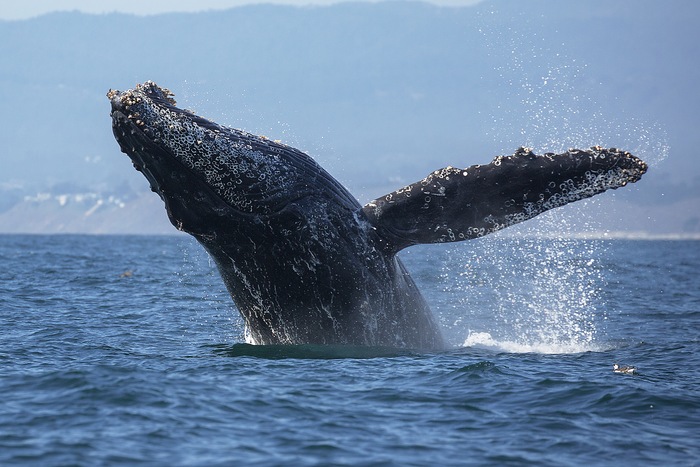A Splashing Adventure: Where to See Whales This Boating Season

All along the West Coast, whale watching fun abounds—and from the comfort of your Chaparral, you’ve got a front-row ticket to the show.
Wondering where and when to take your whale watching adventure—or even what to wear? We’ve got you covered with answers to these questions and more. Just read on for our go-to guide to all things whale watching this boating season!
Where to go
The first step to any great whale watching adventure? Choosing the perfect spot! Fortunately, all along the West Coast, there are whale watching destinations for every kind of boater. Here are a few of our favorites…
- Santa Barbara, California. This sunny SoCal spot is known for choice surfing, classic Spanish architecture, and—as it turns out—whales! From May onward, visitors can spot blue whales, humpback and minke off Santa Barbara’s lush, mountainous shoreline. Plus, while you’re out on the water, you can extend your adventure by traveling due south—California’s Channel Islands are nearby, offering boaters the chance to discover stunning rock formations, rich blue water and back-to-nature splendor unlike anything on the mainland.
- Monterey Bay, California. Farther up the California coast sits Monterey Bay, another top spot for whale watching—in fact, you can spot many kinds of marine mammals here, from friendly-faced sea otters to harbor seals and many more. Of course, for whale watchers, there’s no shortage of action to behold. At this time of year, you can find humpback and blue whales off the rugged coastline, making it a must-do destination for animal lovers and wildlife seekers of every sort.
- Depoe Bay, Oregon. As we continue to cruise northward, we find Depoe Bay, Oregon, and a one-of-a-kind natural treasure known as the Devil’s Punch Bowl. Here, a natural “bowl” is formed out of coastal rock formations—and when they’re not out surfing or cruising the coast, visitors like watching the water inside fill up and froth around in mesmerizing fashion. From the Punch Bowl viewing area or your very own Chaparral, farther offshore, you can watch for the majestic gray whale all the way through June.
- San Juan Islands, Washington. North of Seattle you’ll find the San Juan Islands, a rustic Pacific escape known for lush green shorelines, enchanting ocean views, and some of the Pacific’s best opportunities for watching orcas in action. The black-and-white “whale” (which is, technically, a dolphin) is a spectacular sight to see on the water, and is well-known throughout the region. The largest of the San Juan Islands is named Orcas Island for this very reason! All season long, you have time to see orcas in action alongside humpbacks, grays and minkes, too. In addition to whale watching, the San Juan Islands are perfect for leisurely cruising, camping and enjoying a one-of-a-kind slice of island life.
What to look for
Now that you know where to go, you’re probably wondering—how do I actually spot a whale, anyway? The answer is, first and foremost, to be observant! Take long, left-to-right looks at the horizon and keep your eyes open for a few tell-tale whale signs, including…
- Blowing water, which might look like smoke on the surface. This is part of the way a whale breathes, so it’s a surefire sign that a whale is around—keep looking!
- Driftwood, or what you think is driftwood! If you spot a log on the horizon that does more than simply bob around or float on the surface, it just might be a whale’s fin. Keep a close eye on it and other items on the horizon.
- Big splashes, which you might hear before you actually spot a whale. They happen when a whale breaches (when a whale “leaps” above the surface and back down again) or moves its tail to head in for a dive. That doesn’t mean the whale is gone, though! Keep watching the area to see where it might resurface.
Whale watching essentials
When preparing for your whale watching adventure, dress comfortably! You might choose to bring along a poncho or cozy sweater, since it can sometimes get chilly offshore. Also be sure to bring something to snap a photo with—it can be a camera or simply your smartphone, preferably with some sort of waterproof protection in case of splashes. Finally, bring along some sunscreen and polarized shades, which will help you see the horizon better on sunny days (and perhaps even let you spot that first whale fin or tail before anyone else!).
Tips for whale-friendly fun
When you’re watching whales, you probably don’t want to go very fast anyway—soaking in the moment, and scanning the horizon for whales nearby, calls for a slow or idle approach. In addition to slowing down when you’re within one km of a whale (and slowing more or stopping altogether when you get closer), the Pacific Whale Watch Association advises boaters to keep moving forward when they are in the path of a whale or group of whales.
Ready for your whale watching adventure? With your Chaparral and some choice company, it’s sure to be a memorable experience—so head out and enjoy! And be sure to share your own whale watching stories below.
Bookmark & Share
Previous Article
Next Article
